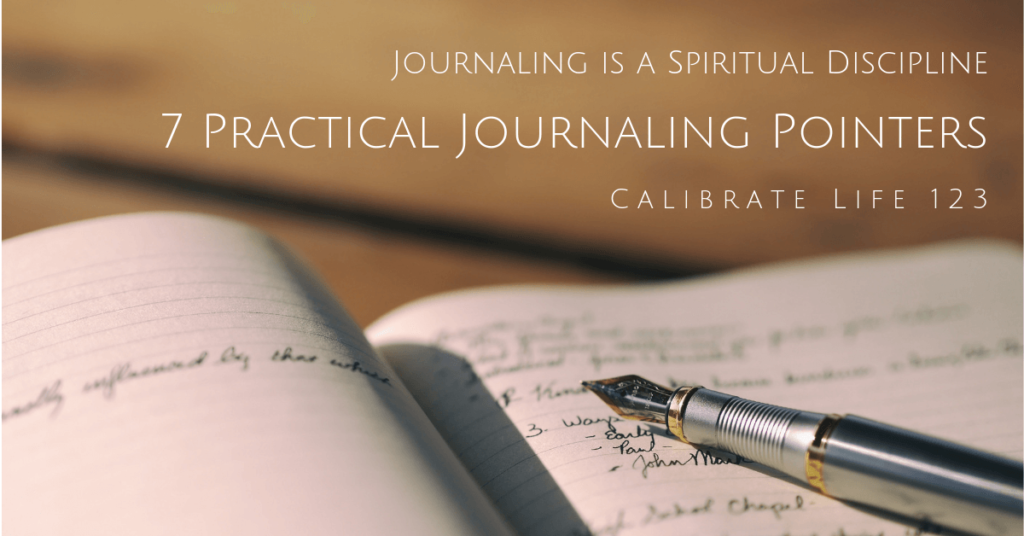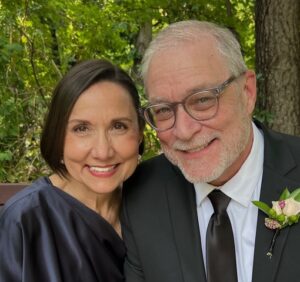Podcast: Play in new window | Download

Journaling is a spiritual discipline and a very important part of a leader’s calibration. In this episode of Calibrate Life we discuss some practical pointers for journaling and a journal template.
Continue Reading for the article and episode notes…
Seven Practical Journaling Pointers
Journaling is one of my strongest disciplines. For me, journaling is a spiritual discipline. It is part prayer, part recording revelation, part recording thoughts and ideas, and part chronicling my journey to give me insight, perspective, and clarity.

Everyone journals differently, some may not find the strength from it that I do, but I believe there is life and spiritual value to the reflection that comes from journaling.
In this episode, we are going to speak practically regarding our “why” for journaling as well as some practical tips for a journal template.
Here are some practical discoveries that have helped me successfully journal for a number of years.
#1… Always date and number your pages
Your journal, among other things, is a contemporaneous record of your journey. You will have thoughts and impressions in a particular context. Later, when you need access to a thought, or need to reference a certain season in your life, you will locate it with ease if your entries are clearly dated.
You would think this would be a “no brainer,” but I have old hand written journals that aren’t dated. Formatting and exporting and importing your journal into different mediums can change page numbers, which I do recommend that you also use, but if each entry is titled by date, that information will remain.
I remember a particular revelation I received one morning during my prayer and reflection time. It was a pivotal revelation for my life, one I am still acting upon. I wrote the impressions in my journal and then went on with my day. Several years later I was prompted to remember that particular entry. I needed to go back and read what I felt God was telling me on that particular occasion. At that time, I was still using a hand written journal, so I could not search my computer. As I thought about the entry I knew where I was when I wrote it. I was in a particular cabin that I do not often frequent. I remembered having to leave my retreat early because a difficult situation arose needing my personal input at my office. I remembered the lake was frozen and there was much snow on the ground and the deck of the cabin. I recalled the year because of the difficult situation. I looked in my journal from that year during the season when there could have been snow, and I found the entry from February 2009.
From a shorter perspective, I often find entries from personal retreats, from out of town trips, and from holidays and vacations because I remember writing about revelations received during those times away. Because the title for each entry is the day’s date, and it is listed at the top of a new page, I can find the entry easier when compared with my calendar.
#2… Use formatting that aids quick visual scanning
Whether you use a leather journal or an electronic journal, long flowing blocks of text that go on for dozens of pages can hide gems that need discovery in the future. Break up your blocks of text. Add headers. Use characters and visual devices.
I begin each year with a title heading large enough that I can read the thumbnail image in my documents folder. I use Heading 1 for the title of my daily entries, which are always titled by date. I use Heading 2 for key passage titles, and I use Heading 3 to identify shifts in thought or items I want to cut and paste to Evernote as a topical resources folder or into a workflow process. Use bold, italics, and underline. Pull out key points by enlarging the font of certain words in line. Change the color of your font for key quotes or things you want your eye to catch when you scan your journal. Of course, if everything is emphasized, then nothing is emphasized, but you will find your unique patterns.
If, on a particular morning, you are journaling from a beautiful place, or you simply want to visually remember the feelings of the moment, snap a photo and drop it into your journal. Marking items for filing and searching is covered in greater detail in another chapter,
but as it relates to formatting, use hashtags and unique visual characters to accommodate future searches.
#3… Use a single document, if possible.
If I’ve got a lot of different notebooks it confuses my life so I try to stick with just one “notebook”, which in the case of my journal is one document. Almost every thought I have during my quiet time starts in my journal. I’ve written articles and sermons in the pages of my journal and later copied them to another document for refining. I prefer having one
life guiding document for each year of my life. In it I record my thoughts, ideas and revelations. I write out the visions I have for life and ministry. When I have a great idea, I develop it in the journal and I later put it into a workflow framework. For the past ten years of my life, all of my great inspirations have been recorded in my journal, and I work on those inspirations in my journal until I eventually trawler them into a workflow framework necessary for building out the idea.
I use the same journal file for the entire calendar year, but if it gets too large and the document starts to move slowly because of the device’s memory, I spilt it into two documents.
#4… Give a brief reference or perspective point.
I often begin a day’s entry with a brief reference point or perspective. This morning’s journal entry began thusly, “Sitting on my patio this morning. It is a beautiful morning. Donna is in Quincy soon to head home. It is so cool and crisp and sunshiny.”
The purpose of my journal is primarily writing things I feel God is saying to me. I record perceptions, important thoughts, and insights. The thoughts and insights from my journal are like a well I draw water from from every day of my life. I do not write long entries about the weather. My journal is NOT a diary (well, sometimes it is, but that is not its purpose).
Sometimes insight into my context is important for remembering my frame of mind. Notice the brevity of my opening statement example. Notice the sentence fragments. These words are not intended for publication (except as how I just used them as an example); but, they provide perspective and insight.
These few and brief opening words will serve a much greater purpose than framing context, they provide a diving board for jumping into your writing. Again and again, I find just getting my fingers moving on the keyboard opens up my spirit and my mind for a flow of revelation, insight, and thoughts. If you don’t write the first word, you will never write a book, or even a useful thought. Writing a few brief observations puts you in touch with the gentle voice within and the heartbeat of God in a way nothing else can.
If something awesome is happening in your life, mention it, it may jumpstart a revelation. If you are facing heartbreak or challenges, mention it, a profound flow may initiate, or you might move quickly in another direction. You never know what resonates with your spirit until you venture a quick look down a path. The greatest insights come when I take a brief look down a path and decide to walk down said path.
#5… Have a short list of questions to consider.
Most every morning, I get a cup of coffee, get my journal, and I begin in prayer and reflection, usually before I start writing. When I put my fingers to the keyboard, often things just start to flow. Some mornings my journal entry consists of just a few words, and that’s all. Some mornings I don’t write anything. On most mornings, I do write.
I have a few questions I ask myself to prompt my thinking, praying, and writing.
What is God saying to me right now?
I am a Christ-follower and my journaling times intertwine with my prayer, reflection, and meditation time—and coffee! The most important question I ask myself every morning is, “What is God saying to me?” In keeping with my life mission to “lay my head on the Father’s chest and listen to his heartbeat…”, listening is the most important thing I do every day. Listening is a spiritual exercise. What is God saying to me? What is the small voice inside me saying? I prompt myself to listen and often, as I write what I’m hearing, insights of the most profound order begin to flow.
What insights have I gained from what I’m reading?
My quiet times often include reading, be it a scripture or a book on any number of topics. Usually, I read some scripture, I gain an insight, and I’m off to the races writing. When I get reflective, a book I’m reading will come to mind and I will begin to write about what I’m reading and develop new thoughts that lift me.
What in my life plan needs my focus?
Years ago I developed a “life plan.” In my coaching and consulting I encourage clients to develop a written vision relating to major areas of focus in their lives. Such plans should be reviewed regularly. A life or vision plan is a living document that does little good if written, put away, and left static. When we listen our plans adjust according to season and circumstance.
When I consider the paths of my life, I will sometimes fill pages of my journal with inspired writing that gives informs the next steps of my life. We will not finish at our desired destination unless we constantly reflect and adjust.
What must I follow up on from previous action items or things I’ve noted to write about “later?”
Journaling leads us down many paths too interesting to explore in a single setting. How can we assure w do not lose passionate thoughts demanding later follow up. I change the font color to red for items I really want to consider later. Scanning back a few days or weeks in my journal I quickly see the “red” items, and they jumpstart my brain and my spirit to dive back into very important lines of thought and revelation.
#6… Identify your action items.
As I just mentioned, I identify action items in red. Take a few moments near the end of your journaling time to scan the page or pages you’ve written and identify items you need to move forward. Everything could be something to move forward, but we are looking for action items that demanding priority for strategic movement in your life. Take a moment to identify these potential action items either in red or with a hashtag.
I sometimes copy and paste these items at the end of the entry so they will be the first things I see the next day. If they are of critical importance, go ahead and move them to your to do list for processing as an action item.
#7… Consider your daily agenda.
If you journal first thing in the morning, which is clearly my bias, it can become a daily launchpad. While you are reflective and prayerful, consider your agenda for the day. Look at your calendar and craft and restructure your agenda. You want to be effective and this brief time before shifting gears and ramping up for the day is invaluable.
Calibration Tools
- Review the purpose of your journal. Based upon the purpose of your journal, what likely information is important for you to draw attention to and highlight for future reference?
- Considering your method of journaling (i.e. handwritten, electronic device application, etc.), what visual techniques will work for you?
- Consider the prompting questions listed in this chapter. What unique questions will you mentally ask yourself to make your journaling time more productive? Develop a list of the questions you feel would be helpful to consider regularly as you journal.
- What template or pattern works best for you? Take a few minutes and sketch out a one page template to help you more effectively frame your journaling.



